
Problem Statement¶
A bank while reviewing its customer base found that they have increased significant number of liability customers (depositors) in comparison to borrowers (asset customers).
Now they want to aggressively increase their asset customers by providing loan against their credit card. This will not only make a balance between the categories of their customer base, but also help them to earn an interest rate with better margin.
The bank had executed a campaign to provide loan but they were not satisfied since they had a single digit success rate. This time they want significantly a better performance without increasing their campaign budget.
Now they have hired a data science company - Analytics Educator, who can guide them to achieve their goals without increasing their cost. Analytics Educator will be using different Machine learning algorithm to solve this problem.
It's a very frequently occurring problem of the financial institutions, hence we have taken up this case study to show our readers how a real life prject is done in the corporate world.
In this FREE case study, Analytics Educator will show all their readers how to get this real life business problem can be solved. We will show you a step by step approach to solve this problem, using machine learning algorithm.
Data description¶
• DATA DESCRIPTION: The data consists of the following attributes:
ID: Customer ID Age Customer’s approximate age. CustomerSince: Customer of the bank since. HighestSpend: Customer’s highest spend so far in one transaction. ZipCode: Customer’s zip code. HiddenScore: A score associated to the customer which is masked by the bank as an IP. MonthlyAverageSpend: Customer’s monthly average spend so far. Level: A level associated to the customer which is masked by the bank as an IP. Mortgage: Customer’s mortgage. Security: Customer’s security asset with the bank. FixedDepositAccount: Customer’s fixed deposit account with the bank. InternetBanking: if the customer uses internet banking. CreditCard: if the customer uses bank’s credit card. LoanOnCard: if the customer has a loan on credit card.
Methodology¶
Here LoanOnCard is the one which we will be predicting (our dependent variable). Rest of the variables are our independent variable.
We will be predicting the dependent variable using different machine learning algorithms like Logistic Regression, Decision Tree and Random Forest. Once done we will compare their results to zero down on the best algorithm.
Aim¶
By using machine learning algorithm we aim to significantly improve the accuracy of our campaign than the base line (the current accuracy which we have)
We are going to import the data into Python¶
import numpy as np
import pandas as pd
import os
import matplotlib.pyplot as plt
pd.options.mode.chained_assignment = None # removes warning messages
os.chdir("C:\\Users\\ASUS")
pd.set_option('display.max_columns', None)
df = pd.read_csv("full_data.csv")
# Preview our data
df.tail()
| Unnamed: 0 | ID | Age | CustomerSince | HighestSpend | ZipCode | HiddenScore | MonthlyAverageSpend | Level | Mortgage | Security | FixedDepositAccount | InternetBanking | CreditCard | LoanOnCard | |
|---|---|---|---|---|---|---|---|---|---|---|---|---|---|---|---|
| 4975 | 4995 | 4996 | 29 | 3 | 40 | 92697 | 1 | 1.9 | 3 | 0 | 0 | 0 | 1 | 0 | 0.0 |
| 4976 | 4996 | 4997 | 30 | 4 | 15 | 92037 | 4 | 0.4 | 1 | 85 | 0 | 0 | 1 | 0 | 0.0 |
| 4977 | 4997 | 4998 | 63 | 39 | 24 | 93023 | 2 | 0.3 | 3 | 0 | 0 | 0 | 0 | 0 | 0.0 |
| 4978 | 4998 | 4999 | 65 | 40 | 49 | 90034 | 3 | 0.5 | 2 | 0 | 0 | 0 | 1 | 0 | 0.0 |
| 4979 | 4999 | 5000 | 28 | 4 | 83 | 92612 | 3 | 0.8 | 1 | 0 | 0 | 0 | 1 | 1 | 0.0 |
Observations: Here LoanOnCard is our dependent variable, and we are going to predict it using the features (independent variables). Here 1 means these customers had taken the loan in the last campaign and 0 means they had not taken the loan.¶
We can see that there are some unnecessary variables like ZipCode which we will delete.¶
Rest of the variables are numbers, but there might be some categorical variables, which we will understand by checking their frequency distributions¶
# frequency dist for all variables
for column in df.columns:
print("\n" + column)
print(df[column].value_counts())
Unnamed: 0
2047 1
4659 1
553 1
4651 1
2604 1
..
1222 1
3271 1
1226 1
3275 1
2049 1
Name: Unnamed: 0, Length: 4980, dtype: int64
ID
2047 1
2612 1
4651 1
2604 1
557 1
..
3271 1
1226 1
3275 1
1230 1
2049 1
Name: ID, Length: 4980, dtype: int64
Age
43 149
35 148
52 145
54 143
58 143
30 136
50 136
56 135
41 135
34 134
39 132
59 132
57 132
51 129
60 126
45 126
46 126
42 126
31 125
55 125
40 124
62 123
29 123
61 122
44 121
32 120
33 119
48 117
38 115
49 115
47 112
53 111
63 108
36 107
37 105
28 103
27 90
65 79
64 78
26 78
25 51
24 28
66 24
23 12
67 12
Name: Age, dtype: int64
CustomerSince
32 154
20 148
5 146
9 145
23 144
35 143
25 142
28 138
18 137
19 134
26 133
24 130
3 129
14 127
30 126
34 125
17 125
16 125
29 124
27 124
7 121
22 121
6 119
15 118
8 118
33 117
10 117
37 116
13 116
11 116
4 113
36 113
21 113
31 104
12 102
38 88
39 85
2 84
1 73
0 66
40 57
41 42
-1 32
-2 15
42 8
-3 4
43 3
Name: CustomerSince, dtype: int64
HighestSpend
44 85
38 84
81 82
41 81
39 81
..
189 2
202 2
205 2
224 1
218 1
Name: HighestSpend, Length: 162, dtype: int64
ZipCode
94720 167
94305 125
95616 116
90095 71
93106 57
...
96145 1
94970 1
94598 1
90068 1
94087 1
Name: ZipCode, Length: 467, dtype: int64
HiddenScore
1 1466
2 1293
4 1215
3 1006
Name: HiddenScore, dtype: int64
MonthlyAverageSpend
0.30 240
1.00 229
0.20 204
2.00 188
0.80 187
...
3.25 1
8.20 1
9.30 1
8.90 1
5.33 1
Name: MonthlyAverageSpend, Length: 108, dtype: int64
Level
1 2089
3 1496
2 1395
Name: Level, dtype: int64
Mortgage
0 3447
98 17
91 16
83 16
89 16
...
541 1
509 1
505 1
485 1
577 1
Name: Mortgage, Length: 347, dtype: int64
Security
0 4460
1 520
Name: Security, dtype: int64
FixedDepositAccount
0 4678
1 302
Name: FixedDepositAccount, dtype: int64
InternetBanking
1 2974
0 2006
Name: InternetBanking, dtype: int64
CreditCard
0 3514
1 1466
Name: CreditCard, dtype: int64
LoanOnCard
0.0 4500
1.0 480
Name: LoanOnCard, dtype: int64
# dropping ID and ZipCode
df = df.drop(["ID","ZipCode"],axis=1)
Check full data with describe function¶
df.describe()
| Unnamed: 0 | Age | CustomerSince | HighestSpend | HiddenScore | MonthlyAverageSpend | Level | Mortgage | Security | FixedDepositAccount | InternetBanking | CreditCard | LoanOnCard | |
|---|---|---|---|---|---|---|---|---|---|---|---|---|---|
| count | 4980.000000 | 4980.000000 | 4980.000000 | 4980.00000 | 4980.000000 | 4980.000000 | 4980.000000 | 4980.000000 | 4980.000000 | 4980.000000 | 4980.000000 | 4980.000000 | 4980.000000 |
| mean | 2509.345382 | 45.352610 | 20.117671 | 73.85241 | 2.395582 | 1.939536 | 1.880924 | 56.589759 | 0.104418 | 0.060643 | 0.597189 | 0.294378 | 0.096386 |
| std | 1438.011129 | 11.464212 | 11.468716 | 46.07009 | 1.147200 | 1.750006 | 0.840144 | 101.836758 | 0.305832 | 0.238697 | 0.490513 | 0.455808 | 0.295149 |
| min | 9.000000 | 23.000000 | -3.000000 | 8.00000 | 1.000000 | 0.000000 | 1.000000 | 0.000000 | 0.000000 | 0.000000 | 0.000000 | 0.000000 | 0.000000 |
| 25% | 1264.750000 | 35.000000 | 10.000000 | 39.00000 | 1.000000 | 0.700000 | 1.000000 | 0.000000 | 0.000000 | 0.000000 | 0.000000 | 0.000000 | 0.000000 |
| 50% | 2509.500000 | 45.000000 | 20.000000 | 64.00000 | 2.000000 | 1.500000 | 2.000000 | 0.000000 | 0.000000 | 0.000000 | 1.000000 | 0.000000 | 0.000000 |
| 75% | 3754.250000 | 55.000000 | 30.000000 | 98.00000 | 3.000000 | 2.525000 | 3.000000 | 101.000000 | 0.000000 | 0.000000 | 1.000000 | 1.000000 | 0.000000 |
| max | 4999.000000 | 67.000000 | 43.000000 | 224.00000 | 4.000000 | 10.000000 | 3.000000 | 635.000000 | 1.000000 | 1.000000 | 1.000000 | 1.000000 | 1.000000 |
Observations: We can see that the minimum value in CustomerSince is a negetive number. This number can't be a negetive, hence we will delete the rows with negetive values¶
df=df.loc[df["CustomerSince"]>=0,]
df.isnull().sum()
Unnamed: 0 0 Age 0 CustomerSince 0 HighestSpend 0 HiddenScore 0 MonthlyAverageSpend 0 Level 0 Mortgage 0 Security 0 FixedDepositAccount 0 InternetBanking 0 CreditCard 0 LoanOnCard 0 dtype: int64
import seaborn as sns
import matplotlib.pyplot as plt
plt.figure(figsize=(20,10))
sns.heatmap(df.corr(), annot=True)
<AxesSubplot:>
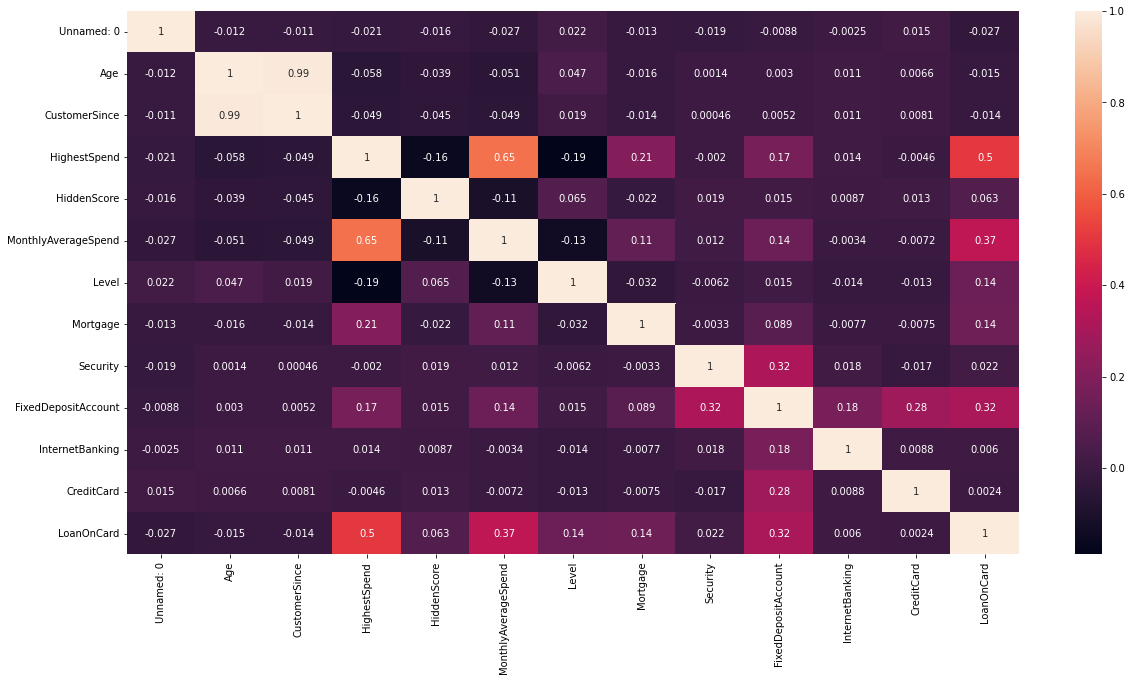
Univariate analysis¶
import seaborn as sns
import matplotlib.pyplot as plt
#Number of data by Level
plt.figure(figsize=[10,5])
sns.countplot(x = 'Level',hue = 'LoanOnCard', data = df)
<AxesSubplot:xlabel='Level', ylabel='count'>
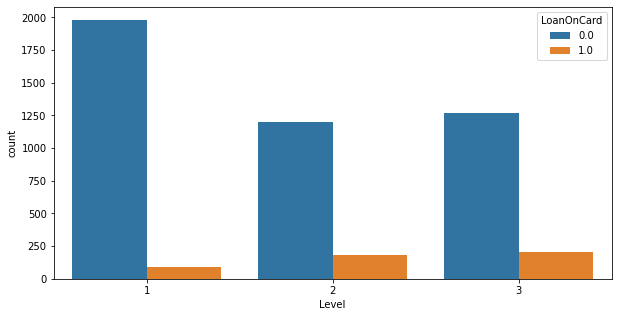
Observations:all values of level have different values; there is a variation¶
#Number of data by HiddenScore
plt.figure(figsize=[10,5])
sns.countplot(x = 'HiddenScore',hue = 'LoanOnCard', data = df)
<AxesSubplot:xlabel='HiddenScore', ylabel='count'>
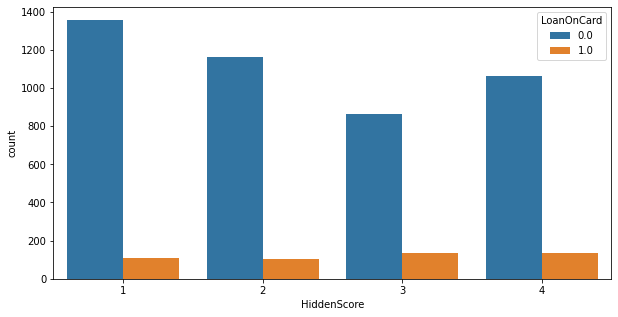
Observations:all values of HiddenScore have sufficient values; there is a variation¶
plt.figure(figsize=(20,5))
sns.countplot(x = 'Age', hue = 'LoanOnCard', data=df)
<AxesSubplot:xlabel='Age', ylabel='count'>

Observations: max age in between 30 - 60¶
#Pair plot
sns.pairplot(df, hue = 'LoanOnCard',
vars = ['Age', 'CustomerSince',
"HighestSpend","MonthlyAverageSpend","Mortgage"] )
<seaborn.axisgrid.PairGrid at 0x2132ea58>
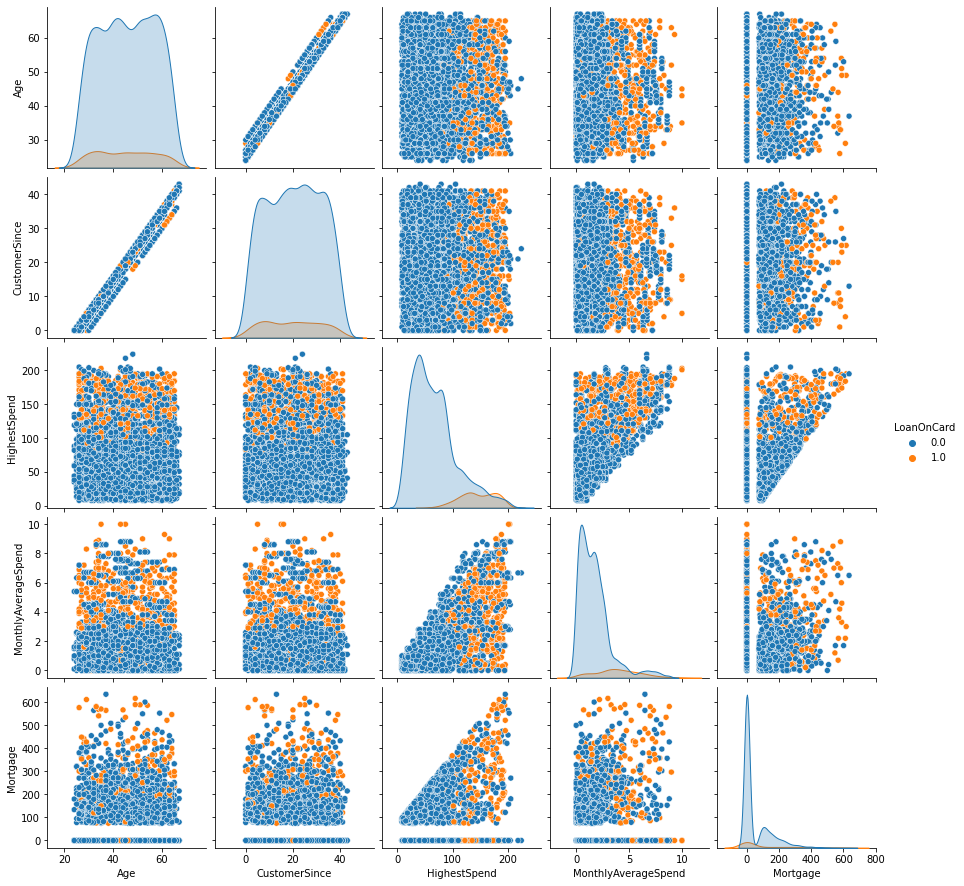
plt.figure(figsize=(20,5))
sns.countplot(x = 'MonthlyAverageSpend', hue = 'LoanOnCard', data=df)
<AxesSubplot:xlabel='MonthlyAverageSpend', ylabel='count'>

plt.hist(df['MonthlyAverageSpend'])
(array([1670., 1346., 1017., 319., 218., 97., 131., 80., 45.,
6.]),
array([ 0., 1., 2., 3., 4., 5., 6., 7., 8., 9., 10.]),
<BarContainer object of 10 artists>)
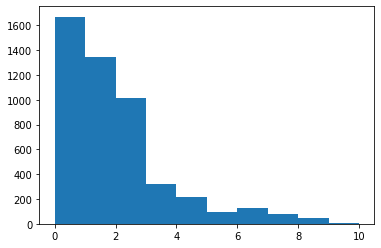
Observations: Most of the spend are within the range of 0 to 3¶
Preparing Data for Machine Learning Algorithms¶
#Let's drop the target coloumn before we do train test split
X = df.drop('LoanOnCard',axis=1)
y = df['LoanOnCard']
#Now we will split the data
from sklearn.model_selection import train_test_split
X_train, X_test, y_train, y_test = train_test_split(X, y, test_size=0.2, random_state=10)
Now we will split the data into training (80% of the data) and rest 20% - named test, will be kept aside for later use.¶
# Fitting Logistic Regression to the Training set
from sklearn.linear_model import LogisticRegression
classifier = LogisticRegression(random_state = 0)
classifier.fit(X_train, y_train)
C:\Users\ASUS\anaconda3\envs\py36\lib\site-packages\sklearn\linear_model\_logistic.py:765: ConvergenceWarning: lbfgs failed to converge (status=1):
STOP: TOTAL NO. of ITERATIONS REACHED LIMIT.
Increase the number of iterations (max_iter) or scale the data as shown in:
https://scikit-learn.org/stable/modules/preprocessing.html
Please also refer to the documentation for alternative solver options:
https://scikit-learn.org/stable/modules/linear_model.html#logistic-regression
extra_warning_msg=_LOGISTIC_SOLVER_CONVERGENCE_MSG)
LogisticRegression(random_state=0)
Predicting the test data¶
#Predict
y_predict_test = classifier.predict(X_test)
Calculate the accuracy of the model¶
#Check accuracy
from sklearn.metrics import classification_report
print(classification_report(y_test, y_predict_test))
precision recall f1-score support
0.0 0.95 0.98 0.97 880
1.0 0.81 0.57 0.67 106
accuracy 0.94 986
macro avg 0.88 0.78 0.82 986
weighted avg 0.93 0.94 0.93 986
Overall accuracy is pretty good (94%). Precision and recall for 1 is 81% and 57% respectively. We might hope to achieve a better result using a separate machine learning algorithm. In the next part we will use Decision Tree and try to improve the result.¶
Now we will be using Decision Tree¶
from sklearn.tree import DecisionTreeClassifier
classifier = DecisionTreeClassifier(random_state=0)
classifier.fit(X_train, y_train)
DecisionTreeClassifier(random_state=0)
Predict the test data¶
#Predict the model
y_pred = classifier.predict(X_test)
Calculate the accuracy of the model¶
#Check accuracy
from sklearn.metrics import classification_report
print(classification_report(y_test, y_pred))
precision recall f1-score support
0.0 0.99 1.00 0.99 880
1.0 0.99 0.92 0.95 106
accuracy 0.99 986
macro avg 0.99 0.96 0.97 986
weighted avg 0.99 0.99 0.99 986
We can see that decision tree has improved the model significantly. Now I have both precision and recall above 90% with overall accuracy to be 99%¶